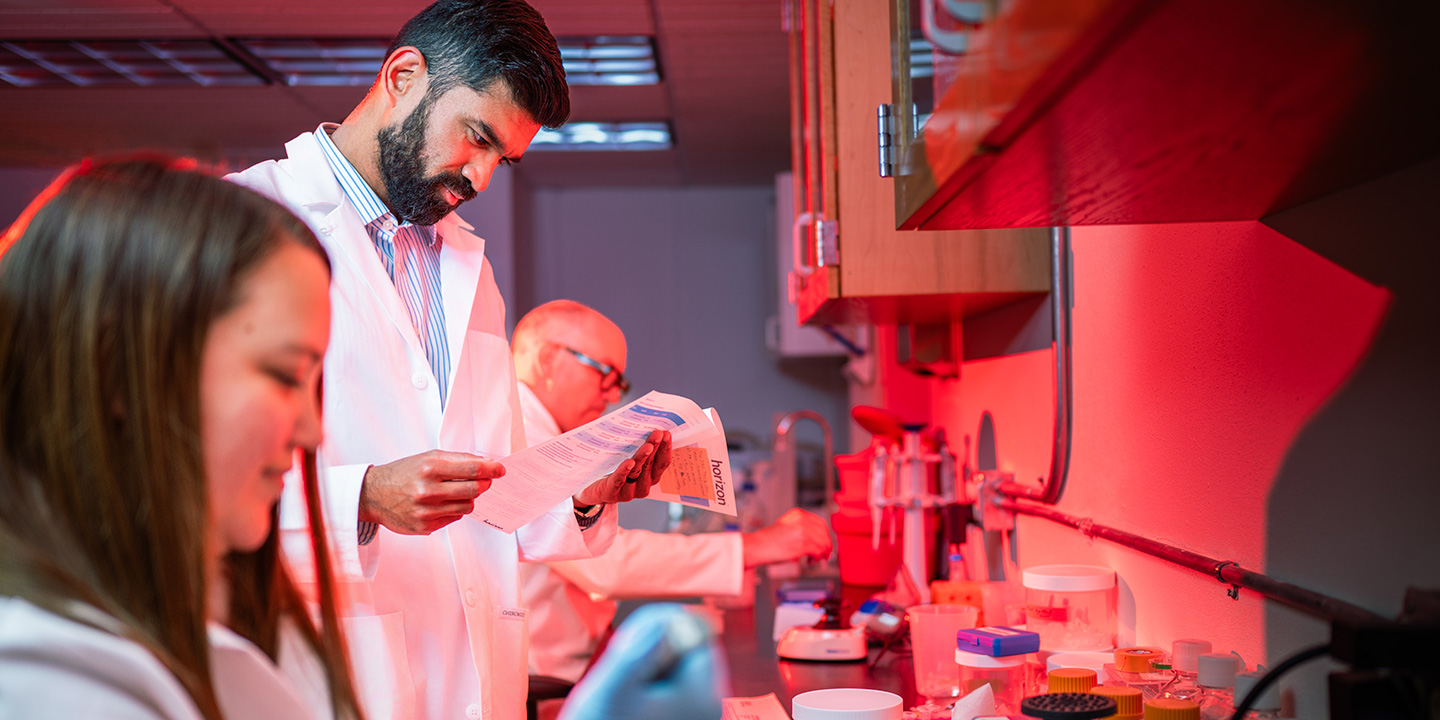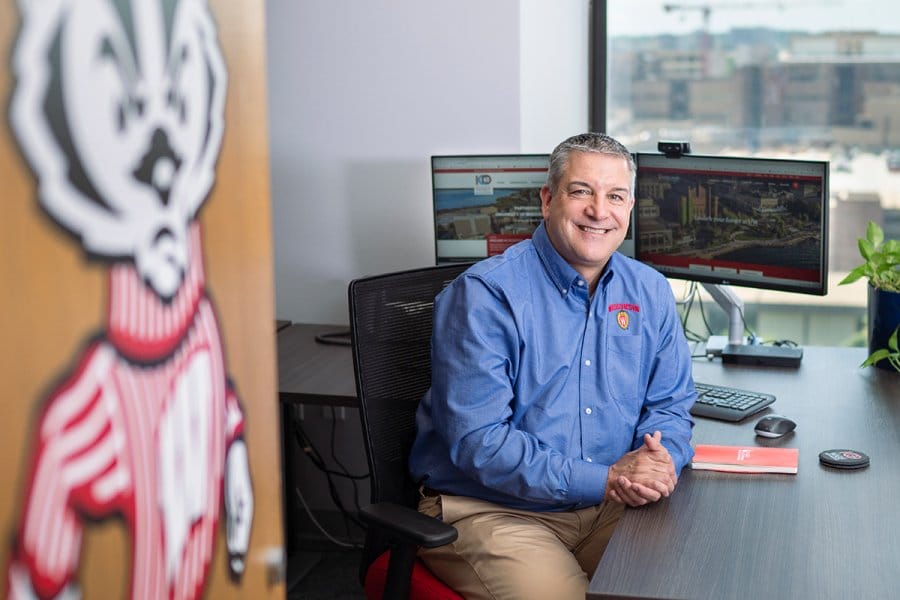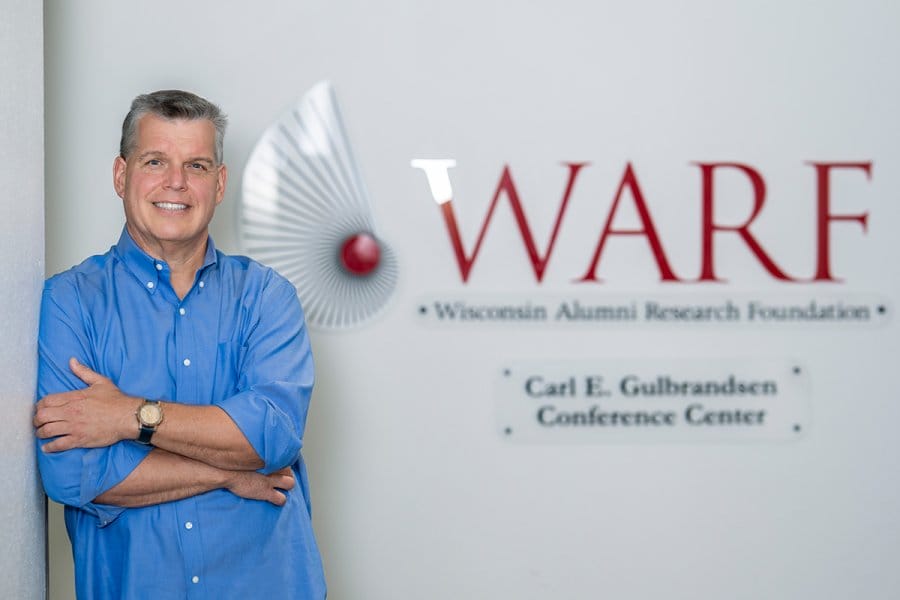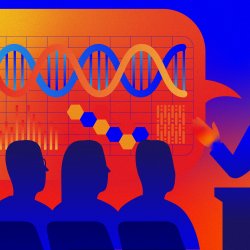
From Idea to Company to Cure
The Wisconsin Alumni Research Foundation helps UW researchers turn science into start-ups.
Faraz Choudhury PhD’17 arrived at UW–Madison seeking a problem to solve. And not a small problem, either.
Choudhury wanted to be an entrepreneur. He didn’t just want to be his own boss, but rather to launch the sort of company that would attract venture capitalists (VCs), one that would be a Very Big Deal.
“Starting a company, you need something that is very groundbreaking, very revolutionary,” he says. “VCs will tell you, don’t make anything that’s marginally better than what you have available today. A VC-backed company would have to have exponential growth. You need to 10X their investment.”
Choudhury thought he was in the right field for that: electrical and computer engineering. As a grad student, he worked in the lab of Professor Leon Shohet, along with Daniel Benjamin ’16, MS’17, PhD’21 and Josh Blatz MS’18, PhD’21. They were using plasma to make microchips better, faster, and more powerful. Computer chips are a promising line of work — they’re vital to the booming AI industry. And Choudhury was willing to be patient.
“I didn’t think entrepreneurship would happen right away,” he says. “I thought I’d go to work for IBM or Intel — I had a job offer from Intel. I’d work there a few years and then eventually start my own company.” He figured Silicon Valley was where he would find his Very Big Idea and venture capital backers.
But in 2016, opportunity walked into the lab in the person of Michael Sussman, a professor of biochemistry. Sussman and his chief scientist, Ben Minkoff, were interested in plasma but not in making computer chips. They wanted to use it to study the structure of proteins. Proteins are one of the keys to disease. Viruses, bacteria, cancerous cells — all have characteristic proteins.
The Shohet lab found a way to help Sussman — a process called Plasma-Induced Modification of Biomolecules, or PLIMB. It was a revolutionary idea, one worth taking to the Wisconsin Alumni Research Foundation (WARF) to have it patented. It was the kind of big idea Choudhury was looking for, and he and Benjamin — along with Shohet, Sussman, Minkoff, and Blatz — decided to launch a start-up company around PLIMB: Immuto Scientific.
Immuto appealed to WARF as much as, if not more than, patenting PLIMB itself. In recent years, WARF has been increasing its role as a venture capital investor for UW-connected start-ups. Immuto seemed like an ideal candidate for investment.
A Better Mousetrap
Build a better mousetrap, and the world will beat a path to your door. Ralph Waldo Emerson is supposed to have said that, or something like it, but you could be forgiven for thinking that it’s WARF’s motto. The foundation’s purpose is to promote inventions. And its history is tied up in rodent removal.
Actually, WARF’s motto is “partnering with University of Wisconsin research to solve the world’s problems,” which is more apt if less evocative.
The foundation began its life 100 years ago, in 1925, at the urging of Harry Steenbock, who wanted the university to control and benefit from the process he invented for enriching foods with vitamin D. WARF patented that process, and many other ideas. WARF’s licenses bring in revenue through royalties, and WARF then returns funding to the university.
Last academic year, WARF’s support for UW–Madison totaled $159.8 million. One of its most successful patent licenses is for warfarin — not a better mousetrap, maybe, but a better rat poison. Warfarin was developed in the 1930s by biochemistry professor Karl Paul Link 1922, MS1923, PhD1925. Later, the chemical at the heart of warfarin was found to be a useful blood thinner to prevent strokes.
Erik Iverson, who has served as WARF’s CEO since 2016, refers to warfarin as one of the university’s “diamonds in the rough.” (See sidebar, below.) It’s one of the inventions that has provided an outsize return to WARF and to the UW.
Since Iverson came to Madison, he’s been looking for ways to create more — and more profitable — diamonds.

Erik Iverson has led WARF since 2016. During his tenure, he has focused on finding “diamonds in the rough,” inventions with potential for high profit.
“When I arrived at WARF, we had our IP [intellectual property — essentially, patent and licensing], which is our bread and butter, the soul of this organization,” Iverson says. “But I was brought on to identify [ways of] both strengthening the licensing pipeline but also broadening out the sources of revenue.”
By broadening the sources of revenue, Iverson means chiefly helping WARF grow into a venture capital investor that puts its money in — and earns significant returns from — UW–based start-ups. Under his leadership, WARF added several new divisions, including WARF Therapeutics, which does drug discovery; WARF Accelerator, which identifies potential start-ups and helps them build the skills and teams that will make them attractive to investors; and WARF Ventures, an in-house VC fund. His hope is to find not only new warfarins but also the companies that will produce and sell those warfarins.
“Warfarin, our namesake, is the most prescribed drug in history as a blood thinner,” says Iverson. “Every successful tech transfer office in the country has a drug in its portfolio. WARF is no different.”
Build a better mousetrap, and the world will beat a path to your door. But build a better drug, and the world will remunerate.
This is one reason why PLIMB and Immuto appealed to WARF. The process has a clear application in drug development. Previously, biochemists could find the structure of proteins only by crystallizing them and then looking at them under an electron microscope. The process is slow and expensive, and it takes proteins out of their natural state, which means the outcome is prone to failure.
“Crystallography takes over a year sometimes to get a single structure. It costs over $100,000,” says Choudhury. “It’s been a big bottleneck in the pharmaceutical industry.”
PLIMB could accurately discover the structure of proteins in their native environment.
WARF saw the possibilities in PLIMB and Immuto right away — it was just the kind of company that WARF’s venture-capital group wanted to back.
De-Risking
To make the UW a player in the world of high-tech entrepreneurship takes more than invention. It takes money. Madison may not have the kind of investor money that New York or San Francisco or Boston can command, but with WARF, it offers a clear method for promoting technology transfer — business-speak for turning ideas into inventions and inventions into products. This is what attracted Iverson to Wisconsin. And it’s what brought Greg Keenan here, too.
Keenan, who heads WARF Accelerator, brought experience from Boston and Silicon Valley, where he had worked in technology start-ups. When he talks about what Accelerator does, the term he comes back to again and again is de-risk.
“We do technology de-risking and market de-risking,” he says. “And what’s exciting now, we’re starting to de-risk teams.”
Risk, of course, is central to venture capitalism — venture is just a synonym for risky. The popular image of venture capitalists is that they embrace high risk for the hope of large rewards. But in general, businesspeople — even VCs — don’t actually like risks nearly so much as they want rewards.
“It’s getting harder and harder to license technologies, because companies are becoming more risk-averse,” Keenan says. “They want to see more proof that these technologies work and can solve the problems they were trying to address.”
Accelerator tries to remove the most obvious kinds of risks.
Each month, WARF holds a roughly three-hour meeting to discuss the new technologies that UW researchers have developed. The university generates between 350 and 400 of these innovations each year, “about one a day,” says Keenan, “and our licensing team and our Accelerator team look at every one. It’s an awesome meeting, an energizing meeting, and a lot of fun.”
Sometimes, as with Immuto, members of the research team want to take their invention to market. Keenan estimates that WARF will seek a patent for about half of the ideas that come in, and for between five and 10 a year, it backs a proposed start-up. Keenan’s Accelerator group keeps a “holding pen” of around 40 ideas that it’s evaluating — de-risking to see if they’re worth backing with venture capital.
What does de-risking entail? The first thing WARF wants to see is “commercialization potential” — does this idea or invention have a market?
“Most of the time, [what we see is] not even a product yet. It’s still just an early-stage technology, maybe an idea, maybe just a kind of lab bench experiment. Translating that into a business or a product is a much, much more challenging activity,” says Keenan. “Ideally, we’re starting with a problem and bringing a solution to that problem. But a lot of times, we have what we call technology searching for a problem. Those are the hardest to sell.”
If the idea does solve a real-world problem, the next question is whether that solution is unique. If existing technologies solve the same problem, then even a new and practical invention can fail in the marketplace.
The next step in de-risking is to prove that the idea or invention works. “Frequently, what we’re funding are prototypes, a field trial, a marketing study,” Keenan says. “We want to meet a milestone that is meaningful to business and industry.”
If a potential start-up can meet those requirements, Accelerator tries to de-risk the team — to ensure that the potential start-up has the necessary talents to be successful.
“Our biggest question is who’s going to run this idea,” says Mike Partsch, who heads WARF Ventures. “The overwhelming majority of the time, the inventor of the technology is a professor on campus. They are a world-renowned scientist, very knowledgeable in their field, but they don’t know anything about running a company. So we need to recruit management talent from outside.”
Once a start-up satisfies Keenan’s Accelerator team, Partsch’s Ventures team will decide whether to invest WARF money. That investment would likely begin with between $250,000 and $500,000 of seed capital and might rise to as much as $10 million over several rounds of fundraising.
But the funding is an investment and not a gift. Most start-ups fail, and as WARF is taking a risk, it expects a sizable reward. Build a better mousetrap, and the world will beat a path to your door. But mousetraps currently sell two for $1.23 at Walmart, and that doesn’t give much room for profit. Venture capitalists want to see much higher potential.
“When we make a million-dollar investment, as a venture capitalist, we want to see a five- to 10-times return in seven to 10 years,” says Partsch. “We expect that investment to realistically be able to make multiples. If we saw an opportunity, and the entrepreneur said, ‘Oh, if you invest in us and we’re wildly successful, you could get a 25, 30 percent return,’ we’d be like, ‘No, not interested.’ ”
Immuto Scientific was one of the first companies to go through WARF Accelerator after Keenan arrived in 2017. “Our funding went in to help the cofounders build the first devices,” he says. Its idea appealed immediately to pharmaceutical companies, and Choudhury struck the WARF team as a strong CEO. WARF saw how quickly Immuto could turn technology into profit.
“The market is undeveloped for this technology, but it’s going to displace the X-ray crystallography market,” Partsch says. “It’s faster; it’s cheaper. It can grow the [drug] market, because companies will now use [Immuto] for every single drug candidate instead of just the 10 percent or so that they think have potential.”
The line from lab to profit seems clear for Immuto. But that’s not the primary direction in which Choudhury wants his company to go.
Successful Exit
Choudhury wants to solve big problems, and the thing about the plan that makes so much sense to Partsch and Keenan — the problems it shows such promise at solving — is that they’re limited. Speeding up drug development is a small problem.
“We knew right away that there was a service business here,” Choudhury says. “And we could make some money on services. But then we thought, how do we make this into a high-growth business? We’ve got to make drugs of our own with this platform.”
For three years, from 2018 until 2021, Choudhury and Benjamin and the Immuto team developed their ideas with WARF Accelerator. Then WARF Ventures put significant money into the company, and for the next two and a half years, Immuto built up its customer base among pharmaceutical firms.
For the team at WARF, Immuto is heading toward what venture capitalists call a “successful exit,” either a stock offering that invites broad public investment or the sale of the company to a bigger, established firm. Either will make all of the early investors rich.
But this isn’t the kind of success Choudhury is hoping for, or at least not the only kind.
While the company was growing, Immuto was looking for an opportunity to solve a big problem — like curing cancer.
Cancer seemed like a prime area for PLIMB investigation because of its nature. Cancers are, essentially, protein problems.
“What happens in cancer is that a protein gets mutated in some way or it gets overexpressed,” says Choudhury. “Drug developers identify these proteins, and then they make drugs against them. But the same overexpressed protein exists in healthy tissues.”
Drug developers often run into problems creating cancer treatments in the lab, because they’re only dealing with a protein drug target in a test tube. If the drug candidate destroys the protein and kills the tumor in a lab setting, it looks like a success. But put it in a live patient, and suddenly it’s causing collateral damage. Now healthy tissues are suffering. Or worse, patients can die of the cure.
PLIMB enables researchers to find a drug that leaves the healthy protein alone. “We can design drugs to the structure of the protein that are only specific to the tumor,” Choudhury says. “When we test that same drug on the healthy tissues, it doesn’t bind to that protein in the healthy tissues.”
Immuto’s opportunity arrived in the form of acute myeloid leukemia, or AML, a cancer that affects bone marrow. The only current treatment for AML is a drug called Mylotarg, which was discovered in 1991, granted accelerated FDA approval in 2000, and removed from the market in 2010, because it caused potentially fatal liver disease. It was approved again in 2017, but carrying a warning that it was associated with “hepatotoxicity, including severe or fatal hepatic veno-occlusive disease.”
Immuto is developing a new treatment for AML, one that is currently being tested in mice. Choudhury believes it might make it to market in the next few years.
For Choudhury, this is the point of entrepreneurship: not making 10X money or building companies, but creating technologies and then using them to help people. It doesn’t greatly matter if that’s through sale to a Big Pharma firm or continuing to go it alone. The goal is to produce cures.
“This is our North Star,” he says. “What can we do to eradicate disease? How quickly can we get a therapeutic to a patient? Because patients are running against time here.”
Build a better mousetrap, and the world will beat a path to your door. But cure a cancer, and you solve a Very Big Problem.
John Allen is associate publisher of On Wisconsin, which, by coincidence, is the magazine you’re reading right now. His capital portfolio is heavily invested in scratch-offs.
Published in the Fall 2025 issue





Comments
Jacques Galipeau September 19, 2025
Madison is an evolving ecosystem for discovery, development and deployment of cures and the WARF’ vision in promoting such is eloquently laid out.
To make the UW a player in the world of high-tech entrepreneurship takes more than invention. It takes money. Madison may not have the kind of investor money that New York or San Francisco or Boston can command, but with WARF, it offers a clear method for promoting technology transfer — business-speak for turning ideas into inventions and inventions into products. Under Erik Iverson’ leadership, WARF added several new divisions, including Jonathan Young’ WARF Therapeutics, which does drug discovery; Greg Keenan’ WARF Accelerator, which identifies potential start-ups and helps them build the skills and teams that will make them attractive to investors; and Michael Partch’ WARF Ventures, an in-house VC fund.
Adjacent to WARF’ gravitational field, UW UW Program for Advanced Cell Therapy (PACT) aggregates discovery and clinical talent of UW SMPH and UW Health and offers the added opportunity of cell therapy products and company creation that can take root in the greater Madison life sciences ecosystem.
The future is now for UW, and WARF’ vision and our accreting cell therapy first-in-human portfolio are going to be awesome for deployment of cures!